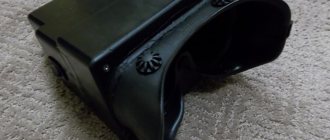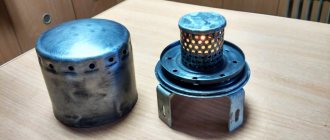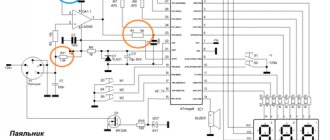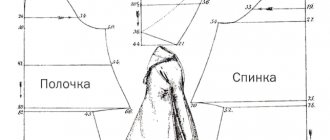To work comfortably in a garage or workshop during the cold season, you do not need to buy expensive oil or infrared heaters.
You can easily make do and replace them with regular incandescent or halogen bulbs. In addition, when using simple lamps, you will also receive a lamp as a bonus.
Operating principle and main elements of an infrared heater
To make an infrared heater from scrap materials, it is necessary to study the operating principle. How can you do something you know nothing about?
All heated bodies radiate heat, just like the Sun does. The rays emanating from a heat source are electromagnetic waves that heat bodies encountered in their path: pieces of furniture and people. In this case, the air does not heat up: the air receives only part of the heat during heat transfer from already heated bodies. Infrared heaters operate on the principle of thermal radiation, which includes two main elements:
- Radiation source . In industrial heaters, these are thin metal filaments that heat up when an electric current passes through them, or lamps (incandescent, halogen, quartz and others);
- Reflector . This is a highly reflective body, the function of which is to reflect infrared rays to disperse heat throughout the apartment or form separate heated zones.
Advice! To check the effect achieved by the reflector, take some food foil and hold it near your hand for a while. You will feel the heat, which is reflected and directed towards you.
Another important part in industrial infrared fireplaces is the controller, which regulates the degree of heating of the emitter. It may not be present in homemade designs. But its installation gives the advantage of being able to set the desired temperature range. The controller automatically causes the device to heat up if the temperature drops below normal, and cool down if the temperature exceeds it.
If you study the infrared ceiling heater, the operating principle will be the same as that of the floor/wall design. The only difference is in the installation method of the IR fireplace. But it depends on him which zones in the room will be more comfortable.
The figure shows the advantage of infrared heaters: heat reaches physical bodies and is absorbed by them, remaining there. Therefore, it may be warmer on the floor than under the ceiling. And when heating a house using the convection method, the floor is always cold: the coating itself does not receive heat. Heat is carried by air, which, when heated, rushes upward, and a new portion of cold air falls down.
Water heating system
The operating principle of any water circuit is based on the transfer of thermal energy from a boiler or furnace to heating radiators. The liquid is moved using a pump or convection.
It consists of the following elements:
- heat exchanger for heating water;
- main pipes;
- circulation pumps;
- metal batteries or registers;
- expansion tank;
- pressure valve, drain taps and filter.
Softened water or ethylene glycol-based antifreeze is used as a coolant.
How to do it quickly and cheaply?
It’s not difficult to make a water heating system for your garage with your own hands. To do this, you will need to calculate the required battery power for the garage and the heat transfer of the heating element. For a water heating installation use:
- electric heating elements;
- electric boiler or solid fuel boiler;
- potbelly stove with a heat exchanger in the firebox;
- waste oil furnace;
- economizer on the stove chimney.
Photo 1. A waste oil furnace is well suited for a garage water heating system.
The simplest electric boiler for a garage can be easily, cheaply and quickly made from a pipe with a diameter of 100–150 mm, placed vertically. A heating element and two water pipes are installed inside.
Having chosen a place for the boiler or furnace in the garage, they begin laying pipes to the radiators. It is better to take pipes from polypropylene (metal-plastic) - they do not rust and are easy to install and connect. Heating radiators in the garage are placed on the walls, leaving a small gap for air circulation. A valve is installed at the highest point to bleed air.
A single-circuit system will operate without an additional pump, due to thermal convection. A more complex circuit will require a circulation pump. The expansion tank will prevent air from entering the system when the liquid level drops due to natural evaporation.
Attention! It is not recommended to use open antifreeze systems in the garage due to harmful ethylene glycol fumes
Advantages and disadvantages
Advantages of water heating of the garage:
- comfortable constant temperature;
- retains heat for a long time after switching off;
- absence of ash, dust and dirt;
- ease of use and the ability to automatically turn on;
- the use of antifreeze makes the system year-round.
Minuses:
- water freezes in winter and destroys pipes and radiators;
- probability of leakage;
- complexity of installation and sealing of the circuit;
Cheap and cheerful
Typically, devices that are heated by electricity are used as an emitter - incandescent filaments or lamps. But the simplest version of the emitter is a heating radiator. This is the same physical body as the Sun. And it can also emit heat. Stand by the radiator and feel the emanating heat - this is radiation. It just spreads in all directions. Why heat the walls if you can direct the rays towards the living space?
Take the foil, smooth it well to improve the reflective effect and stick it on the wall behind the radiators and radiators. As a result, the heat that the walls could receive will be directed in the opposite direction - towards you. This method helps to get up to 20% more heat without any tricks. The only drawback is the ugliness of the reflective screen: it spoils the interior.
Attention! Instead of foil, you can use heat insulators with a reflective screen. A striking example is the material penofol, one or both sides of which are foil-coated.
Water heating
The operating principle of the system is based on the circulation of heated water in a closed loop from the boiler, pipes and heating batteries. The boiler produces heat, heats water, which, usually using a pump, is sent through pipes to the radiators, which heat the room.
Among the undeniable advantages of water heating, it should be noted:
- long service life. Provided high-quality installation and careful operation, the system will serve regularly for decades;
- reliability. If pipes or batteries fail, they can be replaced with your own hands without any problems;
- environmental friendliness and high safety indicators.
Despite its many strong qualities, hydronic heating is very rarely used in garages. Equipment of such a system requires serious financial costs. Most often, such heating is used in cases where the garage is located next to the house or in garage cooperatives, provided that several garages are connected to a boiler and other related units.
Water heating system design diagram
Water heating is best used in permanent garages made of solid concrete blocks and bricks. It is recommended to refrain from installing such a system in buildings made of metal profiles and other lightweight materials.
The old Soviet reflector is in use!
A homemade infrared heater can be made from an old Soviet-made reflector. In addition to this, you will need:
- Nichrome thread;
- Steel rod;
- Fireproof dielectric (ceramic plate is suitable).
To make an IR fireplace from these things, follow the instructions:
- Remove dirt from the reflector;
- Check the plug, cord and terminals to turn on the coil (they must be intact);
- Measure the length of the spiral that is wound around the reflex cone;
- Cut a steel rod the same length as the spiral;
- Wind a nichrome thread onto the rod so that there are 5 turns for every centimeter;
- Carefully remove the rod from the nichrome winding;
- Place the spiral on a plate (another dielectric) so that the turns do not touch each other;
- Connect the ends of the nichrome spiral to the mains;
- Now the heated spiral will easily fit into the grooves of the cone from the reflector;
- Connect the ends of the spiral to the contacts.
The nichrome filament glows better than the spiral that was in the device before our manipulations. As a result, we get a powerful emitter, the energy of which is reflected from the walls of the reflector and hits opposing bodies, which begin to absorb heat.
Video material
These are just four simple ways to create an infrared heater with your own hands. In fact, there are much more of them. The question involuntarily arises: do you need it? There’s a lot of fuss, and it’s not a fact that everything will work out as it should. But:
- Firstly, knowledge is never superfluous.
- Secondly, you kill two birds with one stone. You get a useful device and get rid of a bunch of unnecessary junk.
Maybe it's worth a try?
Heater glass + aluminum foil
You will need:
- Foil;
- Two glasses of the same size;
- Paraffin candle;
- Sealant;
- A wire with a plug at the end;
- Cotton napkin;
- Boxed;
- Cotton swabs;
- Any device for holding a candle.
Step-by-step instruction:
- Clean the glass with a napkin from paint, dust, grease;
- Light a candle. Place it in a glass, candlestick, or simply drip paraffin onto a flat surface and quickly place the candle on the puddle;
- Smoke the glass on one side by passing it over the fire at the same speed. The soot will lie evenly if the glass is cooled before the procedure. The dark layer will eventually become a conductive element;
- Run cotton swabs around the perimeter of the glass pieces so that you get a frame of clean glass 0.5 centimeters thick;
- Measure the width of the smoked rectangles on the glass with a ruler;
- Cut two rectangles of the same width from foil - these will be electrode strips;
- Take one glass and place it with the smoked side up;
- Apply boxing agent to it and place rectangles of foil on the edges so that they extend beyond the glass;
- Place the second glass on top with the smoked side down and press well so that the structure sticks well;
- Along the perimeter of the “layer cake”, spread sealant at the joints of the glass;
- Check the power of the structure. If it is not higher than 100 W per square meter of room, then the heater can be connected to the network using a wire and plug;
- To connect to the network, use a wooden block with metal plates reinforced at both ends. Solder a plug to one contact. If you install the glass on a block so that the foil coming out from the sides fits tightly to the metal contacts, you get a full-fledged heater.
Attention! To calculate the power of a structure, use a multimeter to measure the resistance of the conductive layer. Since the current strength in the circuit depends on the load, it is better to calculate the power using a more stable parameter - this is the voltage, which in the network is equal to 220 Volts. To do this you will need the formula: N=U*U/R .
N – required power. U – voltage (220V). R – measured resistance. Example: when measuring, we got 24 Ohms. Substitute into the formula: N=220*220/24. We get 2016 watts. This is enough to heat a room with an area of 19-20 square meters.
If your power is more than 100 watts per square meter, then it needs to be reduced by increasing the resistance (we cannot change the network voltage). If the power is very low, then it needs to be increased.
What to do if the power is not suitable?
Now let’s talk about how to make an infrared heater with your own hands of the required power. To do this, you need to know the area of the room you want to heat. For example - 15 meters. Now you need to calculate the maximum permissible power at the rate of 100 watts per meter. Since we have 15 of them, the power will be 15 * 100 = 1500 Watts (it is necessary to count in them, despite the fact that in the passports of electrical appliances it is indicated in kW).
If the voltage is constant (220 Volts), then you can calculate the required resistance. To do this, we derive the resistance from the formula given above: R=U*U/N. Substituting the calculated power and voltage into the formula, we get: R= 220*220/1500=32 Ohms (approximately).
In the example above we had 24 ohms. This means that the resistance needs to be increased. To do this, you need to reduce the width of the smoked strip on the glass. This comes from the formula R=l*p/S . Where l is the length of the conductive layer (a constant value, because we will not cut glass), p is the resistivity (constant), S is the cross-sectional area of the conductive layer, which depends on its width. The wider the layer, the lower the resistance, the narrower it is, the greater it is.
Conclusion! To achieve the required resistance, you need to select it experimentally, making the soot strip narrower or wider, depending on whether you need to increase or decrease the resistance. In this case, each time you will have to disassemble the glass structure.
Optimal heating power
To assemble a lamp heater, it is better to use 150W models. Please note that after the introduction of a law prohibiting the production of conventional incandescent lamps with a power above 100W, they began to be sold under the name “heat emitters”.
With their sequential connection scheme, even two copies can be immediately felt radiated heat. At the same time, they do not blind the eyes.
The current in such a circuit at the same voltage will be 420 mA. This means that the two lamps consume about 100 watts in total, and most of them are used for heating.
you can compare the power of infrared heaters sold and the area for which they are designed. The coefficient for conventional models is 100 W per 1 m2.
Oil coolers have almost the same performance.
That is, in any case, watts turn into heat. Only specialized infrared models will have a more direct radiation to a specific point or area, and your DIY product will have a wider angle.
By the way, these 100 W/m2 are accepted by SNiP for insulated premises according to all standards. This is the optimal power for all heaters in central Russia. For northern latitudes, including cold, uninsulated garages, the values will already be higher. If, for example, the heat loss in a garage is 1000 W/h, and you heat it up by 300 W, the temperature will never increase.
But if the ideal heat loss is close to zero, then 100 W will be enough to create a bathroom inside.
In addition, this power depends on the height of the ceilings (calculated average - up to 3 m).
Heater based on laminated plastic
To assemble a homemade infrared fireplace you will need:
- Laminated paper plastic - 2 pieces with an area of 1 square meter;
- Boxed;
- Graphite (you can buy powder or get it from old batteries, from a pencil - but you will have to crush it);
- Copper plates;
- Wood;
- Plug with cord.
If everything is there, start assembling:
- Mix graphite powder with bauxide to form a thick mass with high resistance;
- Place the plastic sheet with the rough surface facing the table;
- Apply bauxide mixed with graphite onto the plastic using zigzag strokes;
- Prepare the second sheet of plastic in the same way;
- Glue both plastic sheets together, pressing them tightly together;
- On opposite sides of the plates, attach copper plates that will act as terminals;
- Build a wooden frame into which you will need to insert the resulting structure;
- Allow the future heater to dry;
- Measure the conductor resistance and calculate the power.
Attention! Here, the calculation of power and resistance is carried out using the same method as in the previous case. Only the resistance will depend not on the width of the conductive layer, but on the graphite content in the box. The more powder, the higher the resistance, and vice versa.
You will have to disassemble and reassemble the structure several times before you experimentally achieve the required power. Only then can you connect the device to the plug and connect it to the network for operation.
Requirements for a homemade device
Most of those who want to try their hand at making a heater themselves are unlikely to strive for too difficult a job.
And the purchase of a large number of different technical elements and components, whose cost is quite comparable to the price of the finished product, is hardly economically justified. Thus, the future device should be:
- easy to install;
- productive;
- economical in energy consumption;
- safe;
- profitable, that is, the costs of its production should be minimal;
- convenient;
- compact.
Considering existing heaters produced by industry, we can conclude that all these requirements are met by devices operating on the principle of infrared radiation. More precisely, the so-called thermal films. The material generates thermal energy that is transferred to objects, which, in turn, heat the environment. This heating method is considered the most effective, since the generated heat is not wasted. Accordingly, the efficiency of such a device is very high.
Mini heater made from a shoe polish can
Prepare materials:
- Flat shoe polish box;
- Two conductors;
- Can;
- Graphite powder;
- Sand;
- Plug.
Step-by-step instruction:
- Wash the box;
- Mix sand with graphite powder, taking them in equal quantities;
- Pour the mixture into the box, filling it halfway;
- Cut a circle out of tin;
- Attach a wire to it;
- Place the circle on top of the graphite-sand mixture;
- Add enough sand and graphite until the jar is full;
- Close the jar with a lid to create pressure inside;
- Connect the second wire to the body of the can and connect it to the network using a plug (you can use a car battery).
To regulate the degree of heating, screw the lid of the jar looser or tighter to change the pressure inside. The tighter the jar is twisted, the stronger the heating, and vice versa. But do not allow it to overheat, at which point the jar begins to emit yellow or orange light rays. In this case, the contents inside the can are sintered, causing the efficiency of the heater to decrease significantly. To improve performance after sintering, you need to shake the jar vigorously - then the graphite-sand mixture will again become loose and suitable for work.











